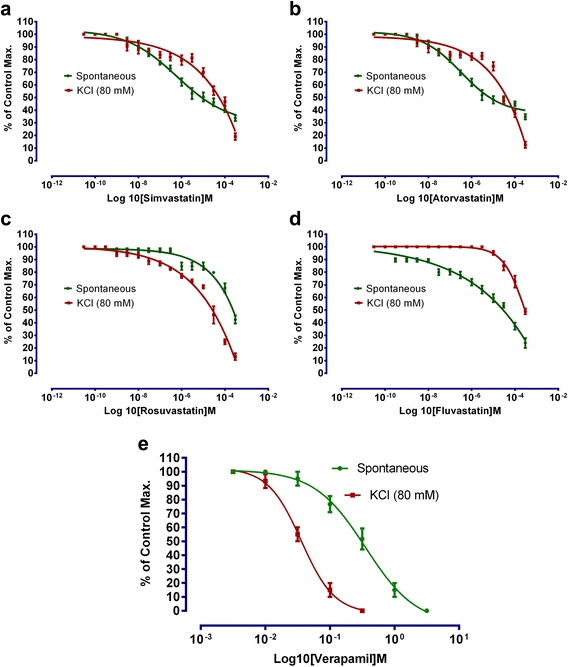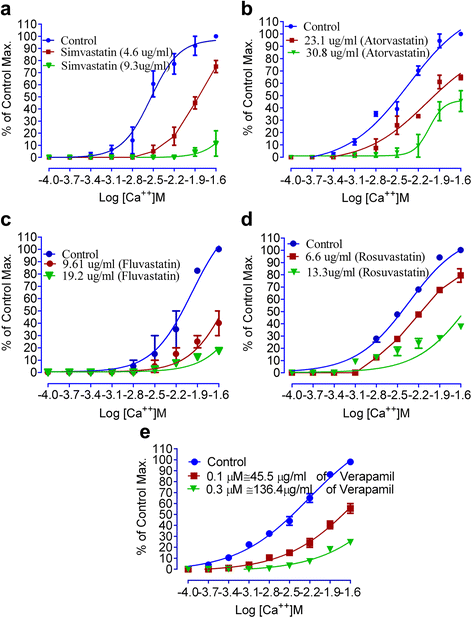Current statins show calcium channel blocking activity through voltage gated channels
- PMID: 27649899
- PMCID: PMC5030724
- DOI: 10.1186/s40360-016-0086-5
Current statins show calcium channel blocking activity through voltage gated channels
Abstract
Background: Statins are used for treatment of hypercholestremia. Common adverse reports associated with use of statins are generalized bodyache, rhabdomyolysis, muscles weakness and gastrointestinal disorders. The current work is an attempt to explain how smooth muscles of gastrointestinal tissues are affected by the current statins (Simvastatin, atorvastatin, fluvastatin and rosuvastatin).
Methods: Effects of the current statins were studied on spontaneous activity of isolated rabbits' jejunal preparations. Different molar concentrations (10(-12)-10(-2)M) of the statins were applied on spontaneously contracting rabbits' jejunal preparations. As statins relaxed spontaneous activity, so we tested the statins on KCl (80 mM) induced contractions in similar test concentrations. Positive relaxant statins were tested again through construction of Calcium Concentration Response Curves (CCRCs) in the absence and presence of the statins using verapamil, a standard calcium channel blocker. CCRCs of statins were compared with CCRCs of verapamil.
Results: Simvastatin, atorvastatin, fluvastatin and rosuvastatin relaxed the spontaneous and KCl-induced contractions. IC50 for simvastatin on spontaneous rabbit's jejunal preparations is -5.08 ± 0.1 Log 10 M. Similarly, IC50 for KCl-induced contractions is -4.25 ± 0.01 Log 10 M. Mean IC50 (Log 10 M) for atorvastatin on spontaneous rabbit's jejunal preparations and KCl-induced contractions are -5.19 ± 0.07 and -4.37 ± 0.09, respectively. Fluvastatin relaxed spontaneous activity of rabbits' jejunal preparations with an IC50 (Log 10 M) -4.5 ± 0.03. Rosuvastatin relaxed spontaneous as well as KCl (80 mM) induced contractions with respective IC50 (Log 10 M) -3.62 ± 0.04 and -4.57 ± 0.06. In case of CCRCs, tissues pre-treated with 4.6 μg/ml of simvastatin, have IC50 = -1.84 ± 0.03 [log (Ca(++)) M] vs control IC50 = -2.54 ± 0.04 [log (Ca(++)) M]. Similarly, atorvastatin, fluvastatin and rosuvastatin produced significant right shift in IC50 for CCRCs (P ≤ 0.05). In case of verapamil, IC50 for control curves is -2.45 ± 0.06 [log (Ca (++)) M], while IC50 in presence of verapamil (0.1 μM) is -1.69 ± 0.05 [log (Ca (++)) M]. Statins produced right shift in the IC50 of CCRCs. The effects of statins are like that of effects of verapamil, a standard calcium channel blocker.
Conclusions: Our findings suggest that current statins have calcium antagonistic effects that act on voltage gated calcium channels that may provide a rationale for cause muscle weakness and gastrointestinal disorders.
Keywords: Atorvastatin; Fluvastatin; Rosuvastatin; Simvastatin; Statins; Verapamil; Voltage gated calcium channels.
Figures


Similar articles
-
Pitavastatin and Lovastatin Exhibit Calcium Channel Blocking Activity Which Potentiate Vasorelaxant Effects of Amlodipine: A New Futuristic Dimension in Statin's Pleiotropy.Medicina (Kaunas). 2023 Oct 10;59(10):1805. doi: 10.3390/medicina59101805. Medicina (Kaunas). 2023. PMID: 37893523 Free PMC article.
-
Atorvastatin and Fluvastatin Potentiate Blood Pressure Lowering Effect of Amlodipine through Vasorelaxant Phenomenon.Medicina (Kaunas). 2023 May 25;59(6):1023. doi: 10.3390/medicina59061023. Medicina (Kaunas). 2023. PMID: 37374229 Free PMC article.
-
Spasmogenic and spasmolytic activity of rind of Punica granatum Linn.BMC Complement Altern Med. 2017 Feb 7;17(1):97. doi: 10.1186/s12906-017-1616-4. BMC Complement Altern Med. 2017. PMID: 28173798 Free PMC article.
-
Effectiveness of long-term using statins in COPD - a network meta-analysis.Respir Res. 2019 Jan 23;20(1):17. doi: 10.1186/s12931-019-0984-3. Respir Res. 2019. PMID: 30674312 Free PMC article. Review.
-
Critical analysis of analytical techniques developed for statins in biological fluids, environmental and fermentation samples.Crit Rev Biotechnol. 2025 Jun;45(4):805-835. doi: 10.1080/07388551.2024.2412128. Epub 2024 Oct 21. Crit Rev Biotechnol. 2025. PMID: 39433471 Review.
Cited by
-
Pitavastatin and Lovastatin Exhibit Calcium Channel Blocking Activity Which Potentiate Vasorelaxant Effects of Amlodipine: A New Futuristic Dimension in Statin's Pleiotropy.Medicina (Kaunas). 2023 Oct 10;59(10):1805. doi: 10.3390/medicina59101805. Medicina (Kaunas). 2023. PMID: 37893523 Free PMC article.
-
Repurposing simvastatin as a therapy for preterm labor: evidence from preclinical models.FASEB J. 2019 Feb;33(2):2743-2758. doi: 10.1096/fj.201801104R. Epub 2018 Oct 12. FASEB J. 2019. PMID: 30312114 Free PMC article.
-
Atorvastatin as an Antihypertensive Agent: A Pilot Study.Cureus. 2023 Nov 27;15(11):e49532. doi: 10.7759/cureus.49532. eCollection 2023 Nov. Cureus. 2023. PMID: 38156151 Free PMC article.
-
Anti-arrhythmic properties of non-antiarrhythmic medications.Pharmacol Res. 2020 Jun;156:104762. doi: 10.1016/j.phrs.2020.104762. Epub 2020 Mar 23. Pharmacol Res. 2020. PMID: 32217149 Free PMC article. Review.
-
Atorvastatin and Fluvastatin Potentiate Blood Pressure Lowering Effect of Amlodipine through Vasorelaxant Phenomenon.Medicina (Kaunas). 2023 May 25;59(6):1023. doi: 10.3390/medicina59061023. Medicina (Kaunas). 2023. PMID: 37374229 Free PMC article.
References
-
- Parish E, Bloom T, Godlee F. Statins for people at low risk. 2015. - PubMed
Publication types
MeSH terms
Substances
LinkOut - more resources
Full Text Sources
Other Literature Sources
Medical
Research Materials

